As much as children and adults look forward to the leisurely days of summer, many also eagerly anticipate the lower temperatures, the crisp air and frosty mornings as well as the pungent smell of apples and pumpkins being harvested that are associated with the autumn. As trees begin to dress themselves in golden and scarlet hues, their last hurrah before being shed for winter’s naked branches, fall beckons everyone to jump into a pile of freshly-raked leaves, to savor the taste and aroma of a marshmallow-filled cup of hot chocolate, and to trade summer linens for flannel sheets. This week’s reviews from members of the International Reading Association's Children’s Literature and Reading Special Interest Group feature books about the season’s turning, something that always happens around this time of year.
GRADES K-3
Duke, Kate. (2012). Ready for pumpkins. New York: Random House/Knopf.
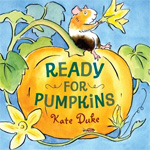 Guinea pig Herky, short for Hercules, is the class pet of Miss MacGuffey’s first graders. He enjoys his lifestyle very much with regular food, water, shelter and lots of attention from all the children who love him. At Halloween he watches the students carve pumpkins, including one they call the Herk-o-Lantern. Herky observes the students and learns about seeds, and he notes how the students plant green beans the following spring. Herky warms to the idea of planting his own garden, and when he is taken home for the summer to the farm of the teacher’s father, he decides to plant the pumpkin seeds he stored over the winter. With his newly-found rabbit friend, Daisy, Herky plants the seeds and then impatiently awaits the plants’ appearance. As the summer weeks pass, Herky grows angry that his seeds aren’t sprouting. When he stamps his feet and digs up a seed to see what is happening, Daisy explains that gardens take a long time to grow. They spend the summer playing games and singing songs. When it is time to go back to school, the pumpkins have still not appeared. The book ends with the teacher’s father bringing a basket of pumpkins to school later in the fall, to Herky’s delight--although Mr. MacGuffey has no idea who planted these surprise pumpkins. Readers may want to visit the author’s website for more background. Teachers may want to choose from a plethora of pumpkin plans at A to Z for Teachers. They will find even more pumpkin ideas at The Virtual Vine website.
Guinea pig Herky, short for Hercules, is the class pet of Miss MacGuffey’s first graders. He enjoys his lifestyle very much with regular food, water, shelter and lots of attention from all the children who love him. At Halloween he watches the students carve pumpkins, including one they call the Herk-o-Lantern. Herky observes the students and learns about seeds, and he notes how the students plant green beans the following spring. Herky warms to the idea of planting his own garden, and when he is taken home for the summer to the farm of the teacher’s father, he decides to plant the pumpkin seeds he stored over the winter. With his newly-found rabbit friend, Daisy, Herky plants the seeds and then impatiently awaits the plants’ appearance. As the summer weeks pass, Herky grows angry that his seeds aren’t sprouting. When he stamps his feet and digs up a seed to see what is happening, Daisy explains that gardens take a long time to grow. They spend the summer playing games and singing songs. When it is time to go back to school, the pumpkins have still not appeared. The book ends with the teacher’s father bringing a basket of pumpkins to school later in the fall, to Herky’s delight--although Mr. MacGuffey has no idea who planted these surprise pumpkins. Readers may want to visit the author’s website for more background. Teachers may want to choose from a plethora of pumpkin plans at A to Z for Teachers. They will find even more pumpkin ideas at The Virtual Vine website.
- Karen Hildebrand, Ohio Library and Reading Consultant
Enslow, Brian. (2012). Fall colors. Berkeley Heights, NJ: Enslow.
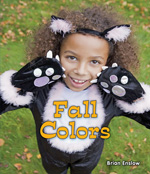 This nonfiction title for beginning readers introduces colors that are especially noticeable during the autumn season. The book opens with a note to parents and teachers discussing how this text introduces concepts and explains that there is an educator’s guide available at www.enslow.com. Each full-page spread contains a colorful photograph depicting an autumn object with two words. For example, one page shows an up close photograph of a maple leaf with its veins and stem. On the opposite page these simple words are included, “yellow leaf” (p. 11). This book is part of a series titled All about Colors of the Seasons. These titles are perfect for children who are learning the basics of reading: how to point to each word as they read, how the illustrations match the words and that reading has to make sense. In addition, this book contains a table of contents, index, websites and more information for early readers interested in learning more about the fall season.
This nonfiction title for beginning readers introduces colors that are especially noticeable during the autumn season. The book opens with a note to parents and teachers discussing how this text introduces concepts and explains that there is an educator’s guide available at www.enslow.com. Each full-page spread contains a colorful photograph depicting an autumn object with two words. For example, one page shows an up close photograph of a maple leaf with its veins and stem. On the opposite page these simple words are included, “yellow leaf” (p. 11). This book is part of a series titled All about Colors of the Seasons. These titles are perfect for children who are learning the basics of reading: how to point to each word as they read, how the illustrations match the words and that reading has to make sense. In addition, this book contains a table of contents, index, websites and more information for early readers interested in learning more about the fall season.
- Deanna Day, Washington State University Vancouver
Farrar, Sid. (2012). The year comes round: Haiku through the seasons. Illus. by Ilse Plume. New York: Albert Whitman.
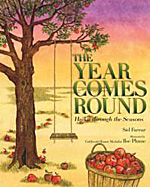 This first-time author states, “The haiku in this book depict little vignettes in the natural world to describe these changes across the seasons and months of the year” (p. 28). Each double-page spread displays one haiku and an illustration of the season. The book begins with winter, depicting Jack Frost and a snowman and then continuing through the changing seasons, ending with a bear getting ready to enter his winter den. The author has included information at the end of the book explaining the pattern used in writing haiku and also the cycle of life depicted within each season of the year. The Caldecott award-winning illustrator has created the companion artwork for each haiku that complements each season and the emotion evoked in the poetry. Teachers might like to try “Haiku Starter” from ReadWriteThink.
This first-time author states, “The haiku in this book depict little vignettes in the natural world to describe these changes across the seasons and months of the year” (p. 28). Each double-page spread displays one haiku and an illustration of the season. The book begins with winter, depicting Jack Frost and a snowman and then continuing through the changing seasons, ending with a bear getting ready to enter his winter den. The author has included information at the end of the book explaining the pattern used in writing haiku and also the cycle of life depicted within each season of the year. The Caldecott award-winning illustrator has created the companion artwork for each haiku that complements each season and the emotion evoked in the poetry. Teachers might like to try “Haiku Starter” from ReadWriteThink.
- Karen Hildebrand, Ohio Library and Reading Consultant
Flatt, Lizann. (2012). Counting on fall. Illus. by Ashley Barron. Toronto, Canada: Owlkids Books Inc.
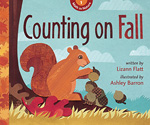 Teachers in search of an interactive math book that serves multiple purposes will enjoy this title. Not only does it focus on elementary mathematics concepts such as counting, estimating, adding, and subtracting, but it also enfolds them in information on the fall season and animals, making it a perfect choice to build text sets and unit plans centered on those topics. Each time readers return to the book, they will perfect their elementary math skills. Readers will be captivated by the text’s playful but challenging and evocative words with activity questions in sidebars. Inviting both aesthetic and efferent reading, the book presents a parade of animals from many ecosystems. Endangered animals such as humpback whales, picas, pronghorn antelopes, Canada geese, brown bats, and black bears are shown busily engaged in a way that invites readers to participate. The pictures are made with layered, tactile collage art, which presents flora and fauna creatively and in their native habitats in eye-catching and bright-colored spreads. A great addition to any classroom or home library, this book would be useful in challenging readers across curriculum areas in an engaging manner.
Teachers in search of an interactive math book that serves multiple purposes will enjoy this title. Not only does it focus on elementary mathematics concepts such as counting, estimating, adding, and subtracting, but it also enfolds them in information on the fall season and animals, making it a perfect choice to build text sets and unit plans centered on those topics. Each time readers return to the book, they will perfect their elementary math skills. Readers will be captivated by the text’s playful but challenging and evocative words with activity questions in sidebars. Inviting both aesthetic and efferent reading, the book presents a parade of animals from many ecosystems. Endangered animals such as humpback whales, picas, pronghorn antelopes, Canada geese, brown bats, and black bears are shown busily engaged in a way that invites readers to participate. The pictures are made with layered, tactile collage art, which presents flora and fauna creatively and in their native habitats in eye-catching and bright-colored spreads. A great addition to any classroom or home library, this book would be useful in challenging readers across curriculum areas in an engaging manner.
- Rani Iyer, Washington State University Pullman
Franklin, Linda Campbell. (2012). Into the pumpkin. Atglen, PA: Schiffer Pub.
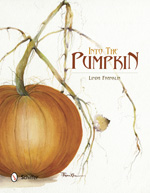 The witch has invited you to take a “peek through the pumpkin” (unpaged) and join all the Halloween regulars at the festivities. Using beautiful and ethereal illustrations, all the eerie characters found on Halloween are busy with the preparations for the party. What should they wear? Costumes or just go as themselves? Witches are laboring over the cauldron, spiders are on websites, skeletons are dancing, and even more preparation and activity bustles as party time approaches. Told in rhyming text, this delightfully scary, but not too scary, picture book will make a great read aloud for primary students. Teachers can have a little fun with their electronic white boards and carve a virtual pumpkin with their students at www.theoworlds.com/halloween or at www.abcya.com/pumpkin_carving.htm, or enjoy Halloween fun and enter the haunted house at the Ben and Jerry’s website.
The witch has invited you to take a “peek through the pumpkin” (unpaged) and join all the Halloween regulars at the festivities. Using beautiful and ethereal illustrations, all the eerie characters found on Halloween are busy with the preparations for the party. What should they wear? Costumes or just go as themselves? Witches are laboring over the cauldron, spiders are on websites, skeletons are dancing, and even more preparation and activity bustles as party time approaches. Told in rhyming text, this delightfully scary, but not too scary, picture book will make a great read aloud for primary students. Teachers can have a little fun with their electronic white boards and carve a virtual pumpkin with their students at www.theoworlds.com/halloween or at www.abcya.com/pumpkin_carving.htm, or enjoy Halloween fun and enter the haunted house at the Ben and Jerry’s website.
- Karen Hildebrand, Ohio Library and Reading Consultant
Goldstone, Bruce. (2012). Awesome autumn. New York: Henry Holt.
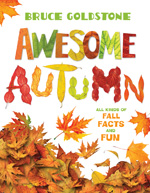 This nonfiction look at fall contains just about every fact and aspect of autumn that a classroom teacher could need. Designed in an oversize format and illustrated with collage pictures and colorful photographs, the book features autumnal features including the wide variety of temperature changes, fall sports, food ripening and harvesting, explanations of trees changing color and losing their leaves, animal migrations, and fall holidays such as Halloween and Thanksgiving. If that’s not enough, there’s even more. This colorful, comprehensive book will serve as an interesting read for primary students as teachers make Common Core social studies and science connections. Teachers might like to use the slide show at the publisher’s website or visit the author’s website or try a lesson place called “Shhh!” Bear’s Sleeping: Learning about Nonfiction and Fiction Using Read Alouds” on ReadWriteThink.
This nonfiction look at fall contains just about every fact and aspect of autumn that a classroom teacher could need. Designed in an oversize format and illustrated with collage pictures and colorful photographs, the book features autumnal features including the wide variety of temperature changes, fall sports, food ripening and harvesting, explanations of trees changing color and losing their leaves, animal migrations, and fall holidays such as Halloween and Thanksgiving. If that’s not enough, there’s even more. This colorful, comprehensive book will serve as an interesting read for primary students as teachers make Common Core social studies and science connections. Teachers might like to use the slide show at the publisher’s website or visit the author’s website or try a lesson place called “Shhh!” Bear’s Sleeping: Learning about Nonfiction and Fiction Using Read Alouds” on ReadWriteThink.
- Karen Hildebrand, Ohio Library and Reading Consultant
Greene, Stephanie. (2012). Princess Posey and the monster stew. Illus. by Stephanie Roth Sisson. New York: Penguin/G. P. Putnam’s Sons.
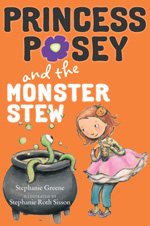 Six-year-old Posey is a little nervous about Halloween this year because the other students in her first grade class say that only babies carry flashlights. In addition, her teacher, Miss Lee, has announced they will be making “monster stew” (unpaged) for Halloween this year, and Posey is not looking forward to that either. However, when she gets home and pulls her tutu out and transforms herself into Princess Posey, she finds a little bit of courage, and she knows she can face any challenge. Posey’s family supports her brave image (and tutu) and help her face her fears to enjoy trick or treat night in her princess costume. Teachers might enjoy this detailed activity guide at the Debbie Gonzales’ website.
Six-year-old Posey is a little nervous about Halloween this year because the other students in her first grade class say that only babies carry flashlights. In addition, her teacher, Miss Lee, has announced they will be making “monster stew” (unpaged) for Halloween this year, and Posey is not looking forward to that either. However, when she gets home and pulls her tutu out and transforms herself into Princess Posey, she finds a little bit of courage, and she knows she can face any challenge. Posey’s family supports her brave image (and tutu) and help her face her fears to enjoy trick or treat night in her princess costume. Teachers might enjoy this detailed activity guide at the Debbie Gonzales’ website.
- Karen Hildebrand, Ohio Library and Reading Consultant
Latta, Sara L. (2012). Why is it fall? Berkely Heights, NJ: Enslow.
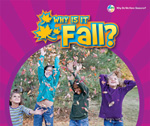 This fun book makes science and weather easy to learn. Full-page photographs along with simple text describe when fall begins, why leaves change colors, what happens to plants in the fall, and what animals do in the fall, concluding with what people do in the fall. One beginning illustration shows how Earth moves around the sun in one year and how it tilts as it goes around. The text then explains, “The tilt causes more or less sunlight to fall on different parts of Earth” (p. 6). In addition, the book contains headings and text boxes. The book also has a science experiment, table of contents, words to know and index. Primary teachers will find this picture book a perfect addition to their classroom library.
This fun book makes science and weather easy to learn. Full-page photographs along with simple text describe when fall begins, why leaves change colors, what happens to plants in the fall, and what animals do in the fall, concluding with what people do in the fall. One beginning illustration shows how Earth moves around the sun in one year and how it tilts as it goes around. The text then explains, “The tilt causes more or less sunlight to fall on different parts of Earth” (p. 6). In addition, the book contains headings and text boxes. The book also has a science experiment, table of contents, words to know and index. Primary teachers will find this picture book a perfect addition to their classroom library.
- Deanna Day, Washington State University Vancouver
McNamara, Margaret. (2012). Apples A to Z. Illus. by Jake Parker. New York: Scholastic.
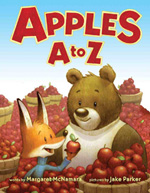 Fox, Bear, and several other forest friends take young readers through the alphabet as they learn about everything related to apples. Each letter of the alphabet represents some aspect of apples, from the deciduous trees that they are, to “G”rafting new breeds, to “V” for the numerous varieties of apple. Comic illustrations make this fact-filled book an enjoyable look at information about apples. The end of the book shares information about Johnny Appleseed, jokes, science and fun facts. Teachers will want to check out this lesson idea entitled “Delicious, Tasty, Yummy: Enriching Writing with Adjectives and Synonyms” at ReadWriteThink.
Fox, Bear, and several other forest friends take young readers through the alphabet as they learn about everything related to apples. Each letter of the alphabet represents some aspect of apples, from the deciduous trees that they are, to “G”rafting new breeds, to “V” for the numerous varieties of apple. Comic illustrations make this fact-filled book an enjoyable look at information about apples. The end of the book shares information about Johnny Appleseed, jokes, science and fun facts. Teachers will want to check out this lesson idea entitled “Delicious, Tasty, Yummy: Enriching Writing with Adjectives and Synonyms” at ReadWriteThink.
- Karen Hildebrand, Ohio Library and Reading Consultant
Roode, Daniel. (2011). Little Bea and the snowy day. New York: HarperCollins/Greenwillow.
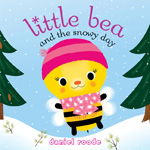 A good read aloud for young readers as the wintery months approach, this title celebrates in simple fashion all the delights of colder weather. Very young readers will enjoy reading the simple story of Little Bea, a bee who spends a day outdoors having fun in the snow with her friends. Since Bea and her friends busily skate, make angels in the snow, and throw snow balls at each other, children who love that time of the year will be able to relate and smile at the idea of Little Bea being covered in the snow and later nursing a mug filled with warm cocoa. Many of the words used are fun to say and describe exactly how Little Bea feels in the frosty air as she says, "Brrrrr" (unpaged) when cold air hits her face and "Wheeee!" (unpaged) as she flies through the snow. The ending will prompt smiles when Little Bea and her friends decide it’s time to make a new friend, and then they literally make one--a snowman, that is. The color-drenched illustrations were created with Adobe Illustrator and Adobe Photoshop.
A good read aloud for young readers as the wintery months approach, this title celebrates in simple fashion all the delights of colder weather. Very young readers will enjoy reading the simple story of Little Bea, a bee who spends a day outdoors having fun in the snow with her friends. Since Bea and her friends busily skate, make angels in the snow, and throw snow balls at each other, children who love that time of the year will be able to relate and smile at the idea of Little Bea being covered in the snow and later nursing a mug filled with warm cocoa. Many of the words used are fun to say and describe exactly how Little Bea feels in the frosty air as she says, "Brrrrr" (unpaged) when cold air hits her face and "Wheeee!" (unpaged) as she flies through the snow. The ending will prompt smiles when Little Bea and her friends decide it’s time to make a new friend, and then they literally make one--a snowman, that is. The color-drenched illustrations were created with Adobe Illustrator and Adobe Photoshop.
- Barbara A. Ward, Washington State University Pullman
Rubin, Adam. (2012). Those darn squirrels fly south. Illus. by Daniel Salmieri. Boston/New York: Clarion Books.
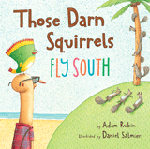 As fall arrives and the leaves begin to fall from the trees, many of the local birds start heading south. Old Man Fookwire is sad to see them go since he loves watching their antics and painting them as they hang out in his backyard. But he’s not the only one who hates to see them go. Those pesky squirrels who seem to plague Fookwire want to know where exactly those birds are heading. They have somehow managed to craft various flying machines that enable them to follow the birds in order to follow those birds. Missing the birds--and, secretly, the squirrels too--Old Man Fookwire decides to climb in his hardly-used car and follow them too. Once he reaches their sunny destination, he is enchanted by the warm climate and relaxed atmosphere, not to mention the exotic birds and beach-front locale. It’s all too much for him, though, and all vacations must come to an end. Eventually, he returns home with the squirrels in charge of the car and the driving. Readers are liable to laugh loudly at the illustration of the cranky old man with squirrels wrapped all around him, even hiding in his pants, draped on top of his head, and clutching his legs in welcome. Even the grumpiest reader will be unable to resist this sweet story about a surprising friendship and the watercolor, gouache, and colored pencil illustrations that accompany it. After all, everyone needs a break from work, and a vacation with those darn squirrels might just be the ticket to relaxation.
As fall arrives and the leaves begin to fall from the trees, many of the local birds start heading south. Old Man Fookwire is sad to see them go since he loves watching their antics and painting them as they hang out in his backyard. But he’s not the only one who hates to see them go. Those pesky squirrels who seem to plague Fookwire want to know where exactly those birds are heading. They have somehow managed to craft various flying machines that enable them to follow the birds in order to follow those birds. Missing the birds--and, secretly, the squirrels too--Old Man Fookwire decides to climb in his hardly-used car and follow them too. Once he reaches their sunny destination, he is enchanted by the warm climate and relaxed atmosphere, not to mention the exotic birds and beach-front locale. It’s all too much for him, though, and all vacations must come to an end. Eventually, he returns home with the squirrels in charge of the car and the driving. Readers are liable to laugh loudly at the illustration of the cranky old man with squirrels wrapped all around him, even hiding in his pants, draped on top of his head, and clutching his legs in welcome. Even the grumpiest reader will be unable to resist this sweet story about a surprising friendship and the watercolor, gouache, and colored pencil illustrations that accompany it. After all, everyone needs a break from work, and a vacation with those darn squirrels might just be the ticket to relaxation.
- Barbara A. Ward, Washington State University Pullman
Stead, Philip C. (2012). Bear has a story to tell. Illus. by Erin E. Stead. New York: Roaring Brook Press.
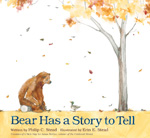 As leaves begin to fall from the branches of trees and the autumn comes to an end right before winter sets in, Bear has a story to tell. He knows he doesn’t have much time since so many of his friends are leaving, and he, too, will need to find a den for the duration of the wintery months. But every time he approaches someone, he is dismissed. As much as they’d like to make time for Bear’s story, Mouse, Duck, and Frog are busily preparing for winter, and they simply can’t stop for him. In fact, Mole is already fast asleep. Since no one has time for his story, and a story always needs an audience, Bear resolves to remember to share his story when spring returns. But the winter months are long, and he can’t remember what story he wanted to tell once he awakens. After several unsuccessful attempts, he must rely on his friends, each of whom makes a contribution to the story’s content. Readers will be engaged by the simple but precise text and the illustrations that show how tired Bear is as he wanders through the forest in search of a listener. Despite his own preoccupation, he still manages to help his animal friends, even lifting a paw into the air to see what direction the wind is blowing as Duck prepares to fly away. The rapidly-diminishing fall foliage, the falling snowflakes, and then the greens of spring on the book's pages show the passage of time.
As leaves begin to fall from the branches of trees and the autumn comes to an end right before winter sets in, Bear has a story to tell. He knows he doesn’t have much time since so many of his friends are leaving, and he, too, will need to find a den for the duration of the wintery months. But every time he approaches someone, he is dismissed. As much as they’d like to make time for Bear’s story, Mouse, Duck, and Frog are busily preparing for winter, and they simply can’t stop for him. In fact, Mole is already fast asleep. Since no one has time for his story, and a story always needs an audience, Bear resolves to remember to share his story when spring returns. But the winter months are long, and he can’t remember what story he wanted to tell once he awakens. After several unsuccessful attempts, he must rely on his friends, each of whom makes a contribution to the story’s content. Readers will be engaged by the simple but precise text and the illustrations that show how tired Bear is as he wanders through the forest in search of a listener. Despite his own preoccupation, he still manages to help his animal friends, even lifting a paw into the air to see what direction the wind is blowing as Duck prepares to fly away. The rapidly-diminishing fall foliage, the falling snowflakes, and then the greens of spring on the book's pages show the passage of time.
- Barbara A. Ward, Washington State University Pullman
GRADES 3-5
Jenkins, Emily. (2012). Invisible Inklings: Dangerous pumpkins. Illus. by Harry Bliss. New York: HarperCollins/Balzer + Bray.
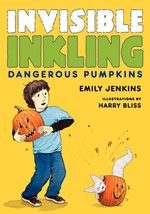 This is the second book in the new middle grade series about Hank Wolowitz and his invisible bandapat friend, Inkling. In this latest adventure, fourth-grader Hank has lost his best friend when he moved away. Now there is no one to go trick or treating with and because of the strange way he has been acting due to his invisible friend Inkling, Hank is lonely. In addition, Inkling has cultivated a fondness for the taste of pumpkins. In fact, he likes pumpkins so much that he even eats Hank’s sister Nadia’s hand-carved pumpkin art projects, leaving Hank to take the blame. Trying to keep Inkling fed, Hank is going broke from his meager earnings at the family’s ice cream store. From imaginary friends to the trials and triumphs of real friendships, this early chapter book provides a story with which intermediate age kids will identify. Teachers may enjoy having an inside view of the book at the publisher’s website. For a fun way to introduce an Inkling watch and listen to the author talking to an inkling, teachers may want to take a look at the author's website. Also see In Other Words: Emily Jenkins (Invisible Inkling series) Finds Her Protagonist on the Engage blog.
This is the second book in the new middle grade series about Hank Wolowitz and his invisible bandapat friend, Inkling. In this latest adventure, fourth-grader Hank has lost his best friend when he moved away. Now there is no one to go trick or treating with and because of the strange way he has been acting due to his invisible friend Inkling, Hank is lonely. In addition, Inkling has cultivated a fondness for the taste of pumpkins. In fact, he likes pumpkins so much that he even eats Hank’s sister Nadia’s hand-carved pumpkin art projects, leaving Hank to take the blame. Trying to keep Inkling fed, Hank is going broke from his meager earnings at the family’s ice cream store. From imaginary friends to the trials and triumphs of real friendships, this early chapter book provides a story with which intermediate age kids will identify. Teachers may enjoy having an inside view of the book at the publisher’s website. For a fun way to introduce an Inkling watch and listen to the author talking to an inkling, teachers may want to take a look at the author's website. Also see In Other Words: Emily Jenkins (Invisible Inkling series) Finds Her Protagonist on the Engage blog.
- Karen Hildebrand, Ohio Library and Reading Consultant
These reviews are submitted by members of the International Reading Association's Children's Literature and Reading Special Interest Group (CL/R SIG) and are published weekly on Reading Today Online.
The International Reading Association partners with the National Council of Teachers of English and Verizon Thinkfinity to produce ReadWriteThink.org, a website devoted to providing literacy instruction and interactive resources for grades K–12.